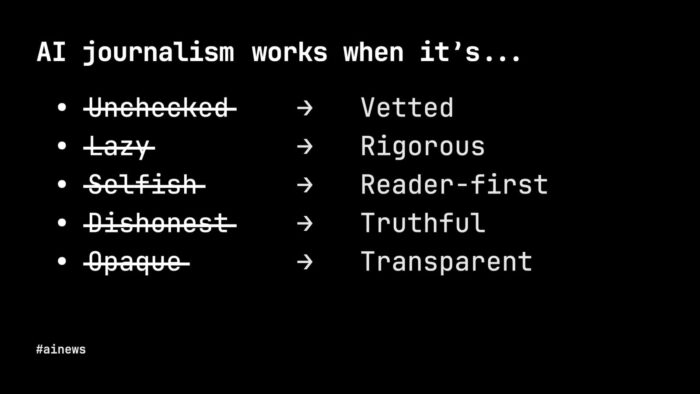- Digital Media Products, Strategy and Innovation by Kevin Anderson
- Posts
- What news organisations can learn from John Deere's marketing mistakes
What news organisations can learn from John Deere's marketing mistakes
84% of journalists say that burnout affects them personally, a study offers solutions

What lessons can journalism organisations learn from an agricultural (and construction) equipment maker? Relationship marketing. It is a branch of marketing that focuses on creating long-term relationships with customers by focusing on their satisfaction. The goal is to build a deep sense of brand loyalty. For the media, this leads to the kind of retention that is a major goal of subscription businesses.
I grew up surrounded by the cornfields of Illinois. I helped my friends not far away in Wisconsin milk their dairy heard and collect eggs on their farm, and my mother’s farm in central Illinois is still in the family. Farmers where I grew up primarily bought International tractors, which were red, or John Deere, which were green. John Deere always seemed to garner the most loyalty, and you can still buy t-shirts, hats, posters and all kinds of things emblazoned with “I bleed green”. That’s the kind of loyalty John Deere elicits from farmers. Most journalism organisations would love to have such fanaticism amongst their customers.
Newspapers did at one point. Growing up west of Chicago, I grew up reading Mike Royko, who was one of the singular voices of Windy City journalism. He is one of many journalists on the Wall of Fame at another Chicago institution, the Billy Goat Tavern. The wall includes the late, great oral historian and radio host Studs Terkel. These were the influencers of their day. The Chicago Tribune and the Sun-Times were the voices of the city that represented very different parts of Chicago society, but you developed a relationship with the voices in their pages, writing about news, society and culture. They were more than columnists shaping opinion. Royko and Studs were the voice of the people, often people who felt like they had very little voice in the machine politics of Chicago.
Relationships take nurturing, and businesses can damage those relationships. During my master’s degree, I studied how John Deere had damaged the relationship that it had created with customers by waging war with them over issues known as “right to repair”. At the time I did the research, farmers in the US were bidding up prices on tractors and harvesters from the 1980s because they were much cheaper and they could service them.More than that, Deere was shutting down licenced service centres, which meant that farmers couldn’t get authorised service in a timely fashion. John Deere made peace with the National Farmers Union in 2023. Their product mix and marketing had cost the company dearly in one of the most important competitive advantages they had: their enviable relationship with their customers.
Journalism companies have done their fair share to alienate their communities, especially those large groups that have bought up local titles and then presided over their decline. In the US, researchers tracking the expansion of news deserts now refer to some titles as ghost newspapers. They say that these titles no longer cover meetings or local breaking news. To me, the bigger issue is that they often have no editors and maybe one or possibly two reporters who are out in the community. Local journalists not only provide coverage, but they are the face of the newspaper. They are the first and most important line in building these relationships essential to building loyalty. As we wrote in the retention report with the Media Collective: successful retention programmes are about relationship management.
When I was a local editor, I tried to be as visible in present in the communities I served. I hosted meetings and tried to get to know people. I knew it was important because I was new to the area. As the job pressure increased, I became more tied to my office. Now, there are just so few journalists working for these newspapers that it is difficult to have time to build these relationships.
How do journalism organisations restore their relationship with their audiences? For much of my career, I have advocated or worked to bring journalism closer to the communities they serve, whether that is a geographical community or a community of interest. As Rob Golub says in this piece, “Our revenue models are strengthened when our news products are lathered in community love.”
It goes back to what I wrote about earlier in the year, which is that information wants to be free, but it also wants to be expensive. In this context, providing a sense of connection in your community is a rare thing that people value. After the pandemic and with the increasing toxicity of social platforms, people crave positive connections. If you can help provide that in your community, it provides a tremendous value.
It is, of course, a balance. People will want news, but if you can do news plus community connections, you build the kind of relationships that build brand loyalty. I have done this kind of work before for large media brands including the BBC, the Guardian and Gannett. I think the one thing I would do differently is build the business model into the community model.
And now onto the links for this week.
The International Press Institute explores a theme that I have been writing about recently, which is how to uncover the unmet and latent needs of audiences. The newsletter includes how to do user interviews with loyal audiences to uncover things they wanted. “(T)hey can tell you when they read the news, what frustrates them about the news, and what makes them engage with your product.” And they said that questions that tapped into users’ emotional needs worked best.
Nick Petrie and I were talking about audience research over a pint recently, and he has some inspiring ideas in his most recent newsletter. News organisations need to invest much more in user research, and I think that academic institutions can do more to support news innovation by doing research for those outlets that can’t afford it. Nick says that news organisations need to be much more engaged with their audiences around novel news products. “Talk to them, show them new ideas, run diary studies, listen listen listen and then implement and listen some more,” he says. I could not agree with him more that we have a lot of territory to explore in terms of new concepts.
A good practical piece on using Google Discover as part of your SEO strategy, and I can tell you that from data we have from our customers at Pugpig, Discover drives subscriptions and registration because more relevant content than Google Search.
How AI is entering newsrooms
Google is paying newsrooms, mostly small ones, to test a generative AI tool that can take a ‘seed’ source such as a city council meeting and generate a story from it. The reporter can then add their reporting and check the story. Google also sees a role for the tool to support audience development by generating newsletters and social posts. Alex Kantrowitz has more details.
Zach Seward outlines his vision for AI at the New York Times. After reviewing where its application went awry, he laid out the values that will inform the use of AI at the Times. My view is that with any technology, it is important to consider the value that it delivers to the audience, whether that is better journalism through the unique abilities that AI brings to journalism such as finding patterns from images or unstructured text or an improved user experience. A smart piece to bookmark.
CrowdTangle was an incredibly useful service for both journalists and researchers. Researchers are trying to convince Meta to keep it running until after the large number of elections this year to help combat misinformation.
Journalism has always been a stressful job, and the precarity and low pay have compounded that. The study by the Reynolds Journalism Institute at the University of Missouri found that 84% of journalists said that burnout is affecting them personally. Those who took part say that four-day workweeks and management training could help. I was particularly interested in the relatively high percentage of people who had left journalism and said that management training would be helpful.




